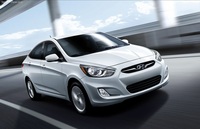2012 Hyundai Accent First Drive And Review
Hyundai Specs, Comparisons and Prices - Hyundai Buyers Guide
2012 Hyundai Accent - Another Potential Hit for the Koreans
By Steve Purdy*
TheAutoChannel.com
Detroit Bureau
We recently had an opportunity to spend some quality time with the Hyundai folks and the new 2012 Accent subcompact, front-wheel drive, sedan and hatchback. We’ll wait until we’ve had a chance to spend some serious road time with the Accent to write a full review, but we’ll offer some details and our initial impressions here. Judging from our brief preview it appears the Accent continues the momentum established by Hyundai with their most recent batch of product updates. That is to say, this one is likely to be a hit as well.
Considering the impressive redesigns of the bread-and-butter Sonata mid-size and Elantra compact sedans our expectations were high for the new sub-compact Accent. Continuing a styling language they call “fluidic sculpture” the car has gone from a plain, white-bread design to something quite special for this class of vehicle. Like it’s larger siblings, , the 2012 Sonic) it will catch your eye going down the road. Accent grows by 3.5 inches in length and 2.8 inches in wheelbase over its predecessor. It competes with Yaris, Fiesta , Versa and Chevy’s Aveo (soon to be replaced by a new little Chevy). Currently, Fiesta is about the only one in the segment with any design flourish.
Accent’s Interior is considerably more upscale than from the car it replaces. A leather wrapped steering wheel, accents of metal and piano-black come together with much nicer plastics and excellent fit and finish to make us feel like we are in a more expensive car. Gauges are accented with soft blue and red to stand out. Controls are simple, intuitive and ergonomically well thought out.
Interior volume is nearly best-in-class with only Nissan’s homely Versa doing better. Cargo capacity for the 5-door hatchback is best-in-class at 21.1 cubic-feet.
Power is nearly best-in-class as well. The new Gamma GDI (gasoline direct injection) engine makes 138 horsepower and 123 pound-feet of torque. Displacing just 1.6-liters this aluminum, inline 4-cylinder engine is 40 pounds lighter than its predecessor. Variable valve timing, an offset crankshaft, electronic throttle controls, variable induction system, a quiet, maintenance-free timing chain and other tidbits combine to make this a fine little engine. The 40-mpg highway fuel economy rating attests to the overall efficiency.
Two transmissions are available - a six-speed manual and a new six-speed automatic with manual mode. On the road neither engine/transmission combination felt particularly impressive, though plenty competent. With the new 6-speed automatic (very unusual in this tiny car class) we expected a bit more grunt. The standard 6-speed manual feels much better if we keep the rpms up. At low end it feels a bit tepid. The manual is light, requiring minimal work to shift and we think it might benefit from a bit more definition in the pattern, at least that’s our first thought. The automatic also includes an “Eco” mode that modifies the engine and transmission to smooth out and deflate overeager acceleration to improve fuel economy. Like every car we’ve recently driven, Accent squeezes every drop of fuel as hard as it can and this miserly approach also dims the fun factor. If you want fun, stick to the manual tranny.
The overall driving experience is less than exciting even with the manual transmission. This is an economy car, after all, with no aspirations for anything more in terms of performance or sportiness. Everything seems to be designed for a light touch. Steering, clutch, shifter, controls; all require too little effort.
Fuel economy is best in class at 40-mpg on the highway and 36-mg in the city. Yes, some Accent competitors have 40-mpg models but you must pay extra for the “eco” or other special edition of those cars. The Hyundai marketing team is taking full advantage of that fact with their cute “Save the Asterisk” campaign. They are saving asterisks by not having to use them in ads about mileage claims.
Fuel savings are not just from the efficient drivetrain. We have electric power steering, extensive use of lightweight steel in the substructure, lightweight suspension components and an exceptionally aerodynamic body.
An easily overlooked contributor to lighter weight, thus fuel savings, is high strength steel. Hyundai says Accent is 59% HSS, which is more than any car we can think of. With improved strength in impact areas and the columns that prevent roof crush, Hyundai says the car is much more rigid, which offers a better and quieter driving experience. It also lets the suspension work more easily at its job of absorbing highway imperfections.
Like its larger siblings, the Accent has interior volume that edges into the next larger size category. By government standards it would be nearly a compact rather than a subcompact.
As you might surmise from these initial comments we like the new Accent, mostly for its style and content, not so much for performance or handling. We think it will do very well in its segment of the market.
* Thom Cannell contributed to this story.
© Steve Purdy, Shunpiker Productions, All Rights Reserved



